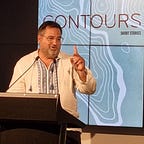Four Things You Should Unlearn From Media Training
Media training has become almost standard for people who get to a certain level of a largish organisation — be it a corporation, a government, or an NGO.
It’s virtually an autopilot decision. “She should go do some media training.” “Have you done any media training?” And, folks dutifully march off to be instructed — usually by some washed-up journo or PR hack who deploys some scare tactics and embarrassing video footage that’s meant to bring a big shot down a few pegs.
I’ve watched political and business leaders give interviews for decades — and been present at many of their training sessions. I’ve given hundreds of interviews across decades — and been trained four times at different outposts of my varied career.
Here’s four things to chuck out the window when it comes to doing media and some alternatives.
1. “Stay On Message.” Nup.
It’s drilled into many doing media training: what are the key messages you want to get across? And once you know them, you’re instructed: make sure that those messages (or talking points or themes) feature in your statements and responses as often as possible. We’re even told we can only have one or maybe three per appearance.
Bullshit. The truth is that modern media consumers are really, really sophisticated and have highly attuned bullshit detectors. They know when they are being spun because they have a vast experience of what is inauthentic, robotic and repetitive. You might think you’re staying safe and controlling the narrative — but you’re sacrificing your credibility in so doing.
The better approach is to respect your audience, including its intelligence. Think about what would be beneficial for them to hear from you. Think about if it was you on the other side of the camera and how you would want the issue, the situation or the opportunity explained to you, your partner, your neighbour or your kids. Decide what overall story you want to tell those folks and weave it through the answers you give to specific questions.
2. “It’s Your Agenda — Not the Journalist’s. They’re Not Your Friends.” Nup.
Another nonsense. It’s appalling advice to suggest to a person doing an interview that the journalist involved is somehow necessarily your opponent or your adversary, or not to be trusted, or basically there to get you. The demonization of journalists right away puts you and a given journalist into a conflictual context. That in turn leads to intentionally antagonistic questions and highly defensive responses — and thereby no real communications and no real benefit to the audience that you’re trying to reach.
The truth is that when you are asked to do a media appearance, even when it’s controversial or about a contentious matter, you’re essentially entering into a deal with a journalist or many journalists. The journalists need content and have an obligation to factuality and their audience. You have content that you need to share and are using journalists as a channel for sharing it. That doesn’t require you to be buddies — it just makes you professional colleagues in that setting, and that’s the way you should accordingly go about transacting your business. Eg, with the same kind of professionalism and discretion that you deal with your boss or your team.
3. “Tuck Your Chin In. Wear This Kind of Tie. Pull Your Shoulders Up Etc.” Nup.
What utter drivel. I challenge the media trainers out there to provide any hardcore empirical evidence that any of these presentational and appearance-based aspects make or break a person’s credibility in terms of a media appearance. Moreover, if you want to look exactly like a major broadcaster’s news reporter — right hair, right make-up, right outfit — you will be exactly as memorable as the dozens of them are. In other words, you won’t be. You will just be another highly-manufactured, cookie-cut non-entity.
Here’s a radical alternative. Just be yourself. Just be true to who you are every day and how you present yourself to the world every day. If you like nice suits, wear one. If you like red glasses with yellow shades, wear them. What matters about your presentation and appearance are that they convey the truth and reality of who you are.
Fakes inevitably fail — in both media terms and life terms. People with integrity remain people of integrity — even when some media appearance didn’t feature you from your best angle.
4. “Prepare and Rehearse, Especially Hard Questions.” Nup.
This common advice reflects the ego of the media industry and its funny notion that it’s somehow at the very centre of things. It ain’t.
Sure, the interview or appearance you’re doing may be significant in the life of your organisation or the lives of your stakeholders etc. It may involve significant information.
But most of us are not regularly involved in media situations where life-or-death information needs to be relayed, say a bushfire emergency. The truth is, whether you do a “good” interview or a “bad” interview, the sun comes up tomorrow. Your business, organisation or government continues by and large doing what it was doing.
Media and communications, though important and to be approached professionally in terms of preparation, are but a small part of reality. Only some people will see you; only some of those are mission-critical, and they have many different ways to get information to make up their minds about you and your cause. So, by all means, know your material — but leave obsessing about every possible angle to people with too much time on their hands, as you have an important job to do.
